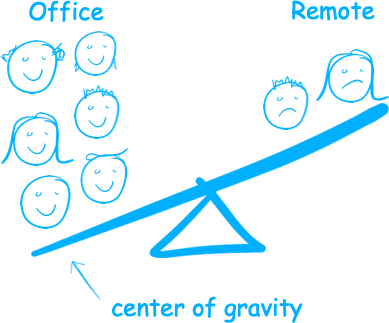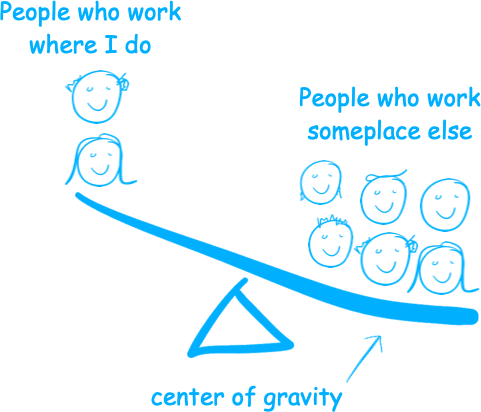As more workers push for remote work, we’ve begun trying to find a common vocabulary to classify how well an organization supports its remote workers. There’s the idea of “remote-friendly” vs. “remote-first” — how do your teams tools and processes enable your remote teammates to succeed? The problem is that these terms are very subjective – it’s hard to assess yourself well with this standard.
I have worked on teams with various remote and distributed configurations, and there’s one factor that seems to determine whether remote employees can succeed — I’m calling it the “center of gravity.” Where is your team’s center of gravity? Let me show you a few examples.
The nominally “remote-friendly” team
You’ve decided to be remote-friendly, which means letting a few of your good people move back to their hometown, or closer to family, or just stop coming into the office. But with the majority of the team still in the office, your center of gravity is in the office. This sets you up for failure. The majority of communication is going to happen in the office over a cubicle wall, or over coffee. When you have a meeting, everyone in the office huddles in a conference room around one shared microphone while the remote employees struggle to hear, and can’t keep up. This type of “remote-friendly” is anything but.
The majority-remote team
Another straightforward example: with most of the team working remotely, your center of gravity is now in remote-land. Your default modes of communication move to remote-friendly tools. Instead of conversations over the cubicle, they’re happening in Slack. Instead of the conference-room-plus-crummy-audio situation above, everyone calls in from their own desk, setting a level playing field.
They may have lost the center of gravity, but people in the office aren’t put into a weaker position, relative to remote workers. They have the same access to the same tools as the remote workers. Everyone can contribute, everyone can be heard.
This works well, but a lot of companies think they can’t get any work done with most of their workers out of the office. There is, however, another configuration I’ve seen, and the results may surprise you.
The distributed team
This is a distributed team. It has the same amount of remote workers as the first example (the in-office center of gravity) except now the in-office contingent is split up among several different offices. Our visual metaphor breaks down a bit here, because the new “center” just depends on how we arrange the faces. So instead of taking the top-down view of the team, let’s draw that same team from any one worker’s point of view:
Even though the majority of people are in an office, from the perspective of any individual teammate, the majority of the team is somewhere else. This forces the team to adopt remote-first tools and processes, even with a mostly in-office team.
This theory is based on my own observations, which are admittedly a small sample size. Have you seen something different? Tell me about it.
Thanks to my colleague Mike Rooney for suggesting an improvement to this post.



